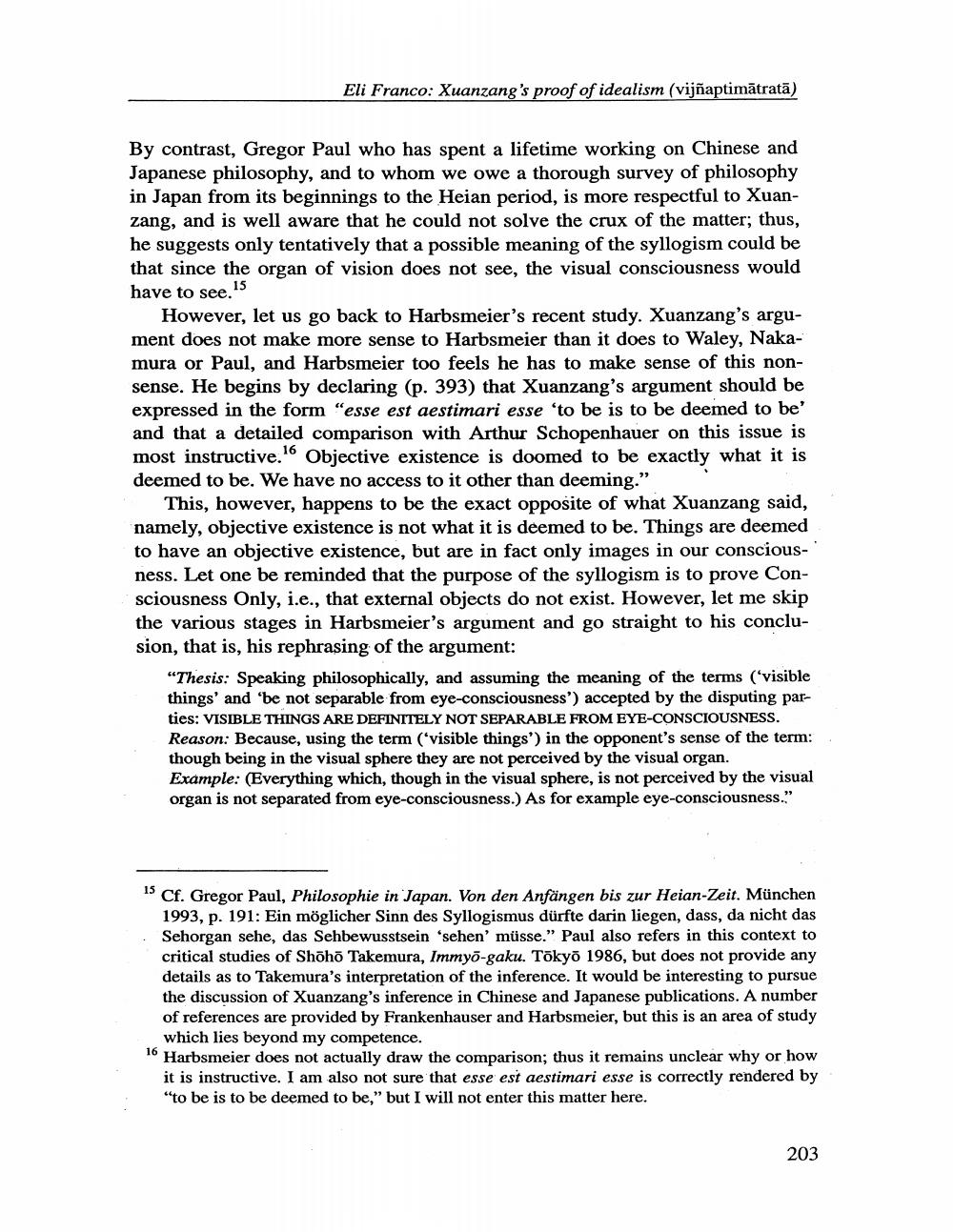________________
Eli Franco: Xuanzang's proof of idealism (vijñaptimātratā)
By contrast, Gregor Paul who has spent a lifetime working on Chinese and Japanese philosophy, and to whom we owe a thorough survey of philosophy in Japan from its beginnings to the Heian period, is more respectful to Xuanzang, and is well aware that he could not solve the crux of the matter; thus, he suggests only tentatively that a possible meaning of the syllogism could be that since the organ of vision does not see, the visual consciousness would have to see. 15
However, let us go back to Harbsmeier's recent study. Xuanzang's argument does not make more sense to Harbsmeier than it does to Waley, Nakamura or Paul, and Harbsmeier too feels he has to make sense of this nonsense. He begins by declaring (p. 393) that Xuanzang's argument should be expressed in the form "esse est aestimari esse 'to be is to be deemed to be' and that a detailed comparison with Arthur Schopenhauer on this issue is most instructive. Objective existence is doomed to be exactly what it is deemed to be. We have no access to it other than deeming."
This, however, happens to be the exact opposite of what Xuanzang said, namely, objective existence is not what it is deemed to be. Things are deemed to have an objective existence, but are in fact only images in our consciousness. Let one be reminded that the purpose of the syllogism is to prove Consciousness Only, i.e., that external objects do not exist. However, let me skip the various stages in Harbsmeier's argument and go straight to his conclusion, that is, his rephrasing of the argument:
"Thesis: Speaking philosophically, and assuming the meaning of the terms ('visible things' and 'be not separable from eye-consciousness') accepted by the disputing parties: VISIBLE THINGS ARE DEFINITELY NOT SEPARABLE FROM EYE-CONSCIOUSNESS. Reason: Because, using the term ("visible things') in the opponent's sense of the term: though being in the visual sphere they are not perceived by the visual organ. Example: (Everything which, though in the visual sphere, is not perceived by the visual organ is not separated from eye-consciousness.) As for example eye-consciousness."
Is Cf. Gregor Paul, Philosophie in Japan. Von den Anfängen bis zur Heian-Zeit. München
1993, p. 191: Ein möglicher Sinn des Syllogismus dürfte darin liegen, dass, da nicht das Sehorgan sehe, das Sehbewusstsein 'sehen' müsse." Paul also refers in this context to critical studies of Shöho Takemura, Immyö-gaku. Tokyo 1986, but does not provide any details as to Takemura's interpretation of the inference. It would be interesting to pursue the discussion of Xuanzang's inference in Chinese and Japanese publications. A number of references are provided by Frankenhauser and Harbsmeier, but this is an area of study
which lies beyond my competence. 10 Harbsmeier does not actually draw the comparison; thus it remains unclear why or how
it is instructive. I am also not sure that esse est aestimari esse is correctly rendered by "to be is to be deemed to be," but I will not enter this matter here.
203




